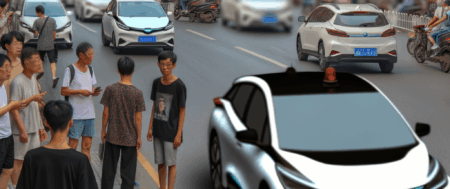In the race to dominate the world’s largest automotive market, both foreign automakers and domestic car brands are focusing on Electric Vehicles (EVs) and New Energy Vehicles (NEVs) to appeal to China’s expanding middle class amid environmental concerns and urbanization. Through joint ventures, strategic partnerships, and understanding the regulatory landscape, these companies are navigating market competition and aligning with consumer preferences for sustainability. Technological advancements, significant government incentives, and catering to local tastes are key strategies as the sector moves towards electrification, showcasing the dynamic interplay between foreign and domestic players in leveraging top technologies and insights to succeed in this growing economy.
In the fast-paced lanes of the global automotive industry, the China automotive market stands out as the world’s largest automotive market, steering ahead with its remarkable production and sales volumes. Amidst a landscape powered by a growing economy, an expanding middle class, and rapid urbanization, China has emerged as a pivotal arena for both domestic car brands and foreign automakers. The market’s acceleration is further fueled by a high demand for Electric Vehicles (EVs) and New Energy Vehicles (NEVs), driven by environmental concerns and robust government incentives. This comprehensive feature delves into the intricate gears of China’s automotive sector, from the surge of electric dreams to the strategic partnerships and joint ventures that are fueling growth amidst a complex regulatory landscape.
As we navigate through “Navigating the Road Ahead: How Top Brands are Winning in the World’s Largest Automotive Market,” we explore the strategies that top players are employing to thrive in this highly competitive and dynamic environment. The spotlight on “Electric Dreams: The Surge of EVs and NEVs in China’s Automotive Landscape” illuminates the pivotal role of electric and new energy vehicles in shaping the future of mobility in China, underscored by government incentives and a growing environmental consciousness.
“Crossroads of Innovation: Joint Ventures and Strategic Partnerships Fueling Growth in China” examines how foreign automakers and domestic brands are leveraging partnerships to navigate the regulatory landscape and tap into the vast consumer base. Meanwhile, “Driving Through Regulation: Understanding China’s Automotive Regulatory Landscape” and “The Pulse of the Market: How Consumer Preferences and Technological Advancements Shape China’s Auto Industry” provide insights into the regulatory challenges and market dynamics that companies must master to succeed.
From the environmental thrust behind “Green Wheels: Government Incentives and Environmental Concerns Accelerating the Shift to Electric,” to the competitive strategies outlined in “The Global Race: Foreign Automakers vs. Domestic Brands in China’s Competitive Automotive Arena,” this article offers a panoramic view of the forces propelling China’s automotive market. “The Urban Engine: How Growing Economy and Urbanization are Steering China’s Automotive Demand” and “Charting the Future: The Impact of Global Economic Trends on China’s Automotive Industry” further analyze the economic and urban factors driving demand, setting the stage for a revolution in “Revolution on the Horizon: The Evolving Dynamics of Market Competition and Strategic Alliances in China.”
Join us on this journey through the lanes of China’s automotive market, where technological advancements, consumer preferences, strategic partnerships, and government policies are driving the future of mobility in the world’s largest automotive arena.
1. “Navigating the Road Ahead: How Top Brands are Winning in the World’s Largest Automotive Market”

In the race to dominate the world’s largest automotive market, top brands are deploying innovative strategies to navigate the complex terrain of China’s booming economy and rapidly urbanizing landscape. With the surge of a middle class eager to embrace mobility, both foreign automakers and domestic car brands are vying for a piece of this lucrative pie. The battleground? A market intensely focused on Electric Vehicles (EVs) and New Energy Vehicles (NEVs), driven by environmental concerns and robust government incentives.
To effectively tap into this vast consumer base, foreign automakers are keenly forming joint ventures with local Chinese companies. This approach not only helps them to smoothly navigate the regulatory landscape but also allows them to align with consumer preferences that lean heavily towards sustainability and innovation. These strategic partnerships are crucial, providing foreign brands with essential local insights and a direct pipeline to the latest technological advancements in the automotive sector.
On the other hand, domestic car brands are not standing by idly. Leveraging their deep understanding of the local market, they are rapidly adopting new technologies and aligning themselves with the government’s push towards NEVs. This home-ground advantage enables them to respond swiftly to market competition and shifting consumer demands, often setting the pace for foreign competitors to follow.
Technological advancements play a pivotal role in shaping the future of the China automotive market. Top brands are investing heavily in research and development, focusing on everything from battery technology and autonomous driving to connectivity features that appeal to China’s tech-savvy consumers. These innovations are not only pivotal for staying ahead in the market competition but are also aligned with the growing environmental concerns that influence consumer behaviour.
The strategic importance of understanding and adapting to consumer preferences cannot be overstated. In a market as diverse and dynamic as China’s, brands that are able to resonate with local tastes and expectations, while also contributing to the broader goals of urbanization and environmental sustainability, are the ones that find success.
Government incentives also continue to play a transformative role in shaping the market dynamics. Policies favoring the development and purchase of EVs and NEVs have created a favorable environment for brands that are ready to invest in these cleaner, more sustainable automotive technologies. This has led to a vibrant ecosystem where innovation flourishes, and the race towards electrification is accelerating at an unprecedented pace.
In conclusion, winning in the world’s largest automotive market requires a multifaceted strategy. Top brands are finding success through a combination of strategic partnerships, technological advancements, and a deep understanding of the regulatory landscape and consumer preferences. As the market continues to evolve, driven by government incentives, environmental concerns, and a growing economy, the ability to adapt and innovate remains the key to navigating the road ahead in China’s competitive automotive sector.
In conclusion, the journey through the world’s largest automotive market reveals a landscape teeming with opportunities and challenges alike. As foreign automakers and domestic car brands alike strive to navigate this complex terrain, the fusion of strategic partnerships and astute understanding of the regulatory landscape emerges as a pivotal factor for success. The growing economy, coupled with rapid urbanization and a burgeoning middle class, continues to fuel an insatiable demand for vehicles, particularly electric vehicles (EVs) and new energy vehicles (NEVs). This shift is further accelerated by government incentives and mounting environmental concerns, making China a hotbed for innovation in sustainable transportation.
The competitive edge in this dynamic market, however, does not solely rest on understanding consumer preferences or mastering technological advancements. Instead, it lies in the ability of brands to adeptly maneuver through joint ventures and align themselves with the pulse of the Chinese consumer, all while staying ahead of market competition. The strategic interplay of these factors dictates who thrives and who merely survives in the bustling arena of China’s automotive sector.
For those looking to make their mark, the China automotive market, with its vast consumer base and emphasis on EVs and NEVs, offers a promising yet challenging frontier. Success in this market is not guaranteed but is attainable for those who can adeptly leverage the unique opportunities it presents. As we look ahead, the evolution of this market will undoubtedly be shaped by further technological advancements, changing government policies, and the global economic climate, making it an ever-important barometer for the global automotive industry at large.







